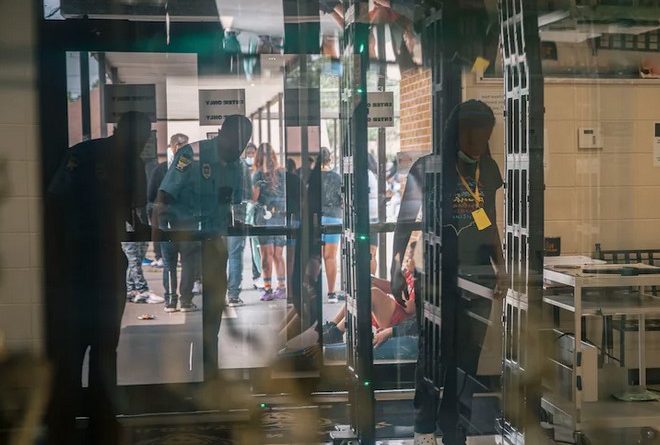Kids keep bringing guns to school. Can AI weapons detectors help?
Although most incidents don’t end with a shooting, more students nationwide have been showing up to school with guns since returning after the pandemic. Fears about school safety are on the rise among students, parents and educators.
The teacher shot at Richneck survived, but since the shooting, at least 10 Virginia school districts have turned to scanners, most using artificial intelligence, to flag weapons at school entrances. Across the country, more schools are installing the weapons detectors, often spending millions to ease concerns and fortify their buildings.
Hopes are that the equipment prevents another tragedy. But skeptics question the scanners’ effectiveness and say they are “security theater” that provides a false sense of safety.
While it’s highly unlikely that most students will experience a school shooting, gun violence nationally is on the rise. According to a Washington Post analysis, the country averaged about 11 school shootings per year through 2017. Starting in 2018, violent incidents began climbing and, in 2022, there were more school shootings — 46 — than in any year since at least 1999.
Evolv, the leading weapons detection technology in schools, markets “noninvasive” systems that can scan thousands of people an hour. Unlike a traditional metal detector, Ev0lv equipment uses AI to identify weapons. The machines use “active sensing” — a light-emission technique that also underpins radar and lidar — to create images that are then compared with the shapes of weapons the AI recognizes. Company officials say the result is a streamlined search that doesn’t require kids to empty pockets or backpacks.
“It’s really fitting into this space in schools where they really want to do something that protects their buildings and keeps them safer,” Evolv’s director of education, Jill Lemond, said. “But at the same time, they don’t want to change the culture and the climate and the welcoming environment.”
When the system identifies a suspicious item, it draws an orange box around it on a live video feed, allowing security personnel watching on a tablet to conduct further screening. The systems are being used across the country in large sports arenas, stadiums and other venues. The company pivoted to schools in 2021 when reports of weapons there began to rise.
Lemond said Evolv’s technology is in more than 450 schools nationwide. This year, the company has signed contracts with Atlanta Public Schools and two systems in Virginia: Prince William County Public Schools, the state’s second-largest, and Alexandria City Public Schools, which launched a pilot of the detectors last month, causing delays to the start of the school day.
At least 14 of Virginia’s 132 school districts use or have plans to implement the AI detection technology. At least another seven have used traditional metal scanners in some capacity. Most use scanners only in middle and high schools, where students are more likely to bring weapons, but the Richneck shooting raised the possibility of more installations in elementary schools.
Nationally, at least 14 percent of high schools, 7 percent of middle schools and 3 percent of elementary schools use metal detectors, according to data from a November survey conducted by the U.S. Department of Education.
Last month, Virginia Gov. Glenn Youngkin (R) announced a $16.4 million competitive grant program to improve security infrastructure in high-need school divisions — including purchasing advanced security equipment and systems.
“The events of the school year now coming to a close remind us that we need to do more to protect our students and the educators to work everyday to prepare them for success,” Youngkin said in a statement.
School security has become a multibillion-dollar market, but school leaders who have experienced shootings have said that security measures are just one part of the solution. They emphasize the importance of developing deep, trusting relationships with students, who often hear about threats before teachers do. They stress that administrators and law enforcement need to quickly respond to those threats. And then there is the need to address the mental health crisis affecting students across the country.
IPVM, a security industry trade publication, cites concerns about the system’s ability to distinguish weapons from other metallic objects, such as Google Chromebooks, which are often used in schools and distributed to students. IPVM also reported that the technology has difficultly recognizing some knives. Last year, the school district in Utica, N.Y., spent $3.7 million on Evolv scanners but removed them from schools in October after a student made it through with a knife in his backpack and stabbed another student multiple times during a hallway fight.
The scanners will also probably do little to protect against weapons during after-school programming or threats outside the building. According to The Post’s database of school shootings as of May 1, at least 14 of 21 shootings this year happened outside school buildings, in cars or parking lots.
“Any student who wants to bring in a weapon can get around a weapon detector, AI or not,” said Andrew Guthrie Ferguson, a professor at American University Washington College of Law. “It’s sad that we’re teaching them to live with this surveillance.”
School leaders who have turned to weapons detectors say they understand that the systems are not going to prevent the most extreme tragedies and that no security system can completely remove the threat of weapons in schools. But they see the detectors as a way to at least reduce the possibility.
Ken Trump, a school security consultant, said that since the 2018 school shooting that killed 17 people in Parkland, Fla., he’s seen the highest level of “anxiety, ambiguity and uncertainty” about school safety from parents.
“It’s the perfect storm for school boards and administrators to turn to metal detectors, and, more specifically, AI weapons detectors, to solve a political and a school community relations problem as much as an actual security [problem],” Trump said.
The Prince William County School Board signed a $10.6 million, four-year contract this month to lease Evolv’s screeners for the county’s middle and high schools. Superintendent LaTanya D. McDade sent a letter to families shortly after the Richneck shooting outlining security steps the school division planned to take, including considering the weapons detection system.
In an interview, McDade said the decision came from a combination of safety concerns stemming from threats and reports of weapons. She worried about how many more weapons were coming into schools than were being reported.
“They want to know what we are doing,” McDade said of parents. “They want to know that their children are safe.”
In North Carolina’s Charlotte-Mecklenburg County, school officials signed a contract with Evolv after the school division reached a record number of firearm confiscations in the first semester — 21 — by December 2021, said Brian Schultz, chief operations officer for Charlotte-Mecklenburg-Schools.
“It was something brought on by the fear, fear of students, fear of parents, fear of the community,” Schultz said.
This past school year, with the detection systems in place, the school division reported six firearms on campus. Two were flagged by the system; two were on campus when school was not in session; in one incident a student with a gun came into school through an unauthorized alternate entrance; and one student was apprehended by police off-campus and found with a gun that they believe had been inside the school.
Schultz said it’s the lowest number of firearms reported in 10 years in the district’s more than 170 schools. He estimates that the school division has recaptured more than 6,000 days of suspension because of the lower number of weapons detected.
“We’re not just talking about the impact at one or two schools,” Schultz said. “The positive impact that’s had on students and staff feeling safe at schools has been tremendous.”
Lemond, the Evolv education director, acknowledged that the system isn’t perfect but says it offers a less intrusive solution that is efficient in identifying weapons, primarily guns.
“We’re helping to reduce the risk. And if it’s a choice between doing something that’s TSA-style and doing nothing, we’re providing an extremely important critical layer of support in these settings,” Lemond said. “But no security system is 100 percent effective.”
McDade, in Prince William, said that she recognizes the system will not stop every weapon and that she never intended for the system to completely remove risk. But she said something needed to be done.
“The critics say ‘Oh, it doesn’t catch everything,’” McDade said. “What’s the alternative? Catching nothing?”
Source: https://www.washingtonpost.com/education/2023/06/11/school-weapons-detectors-ai-virginia/?wpisrc=nl_sb_smartbrief&utm_content=8DB5446A-BF58-4CCB-ABD1-6C0056DE97FA




